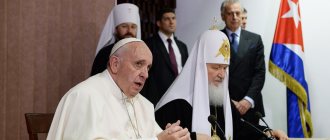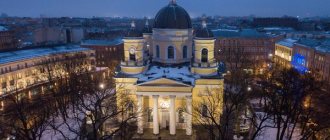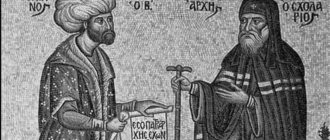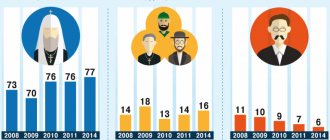Preparation
The Council became a partial implementation of plans to convene a Pan-Orthodox Council (see more details). Due to the manifestation of serious contradictions between the autocephalous Orthodox Churches and the impossibility of holding additional meetings on time to resolve them, during June 2021, the Bulgarian, Antiochian, Georgian and Russian Churches, one after another, refused to participate in the planned Council. The Church of Constantinople, which led the process of preparing the Council, refused to deviate from the planned schedule, and on June 16 the Council nevertheless opened, but with an incomplete composition, having lost the opportunity to be called “Pan-Orthodox.”
Composition and regulations
All 14 mutually recognized local autocephalous Orthodox Churches were supposed to participate in the Council, but only 10 were represented: Constantinople, Alexandria, Jerusalem, Serbian, Romanian, Cyprus, Hellenic, Albanian, Polish and Czech lands and Slovakia; The partially recognized Orthodox Church in America did not receive an invitation to the Council. In addition to the primates and bishop delegates (24 or less from each Church), the arrival of special consultants from local Churches was allowed: clergy, monks or laymen (“usually” no more than 6), as well as 3 support staff. The arrival of non-Orthodox observers, who were allowed to attend the opening and closing of the Council, was also expected.
- From the Church of Constantinople, according to the announcement of May 26, 2016, the conciliar delegation included:
- Bartholomew (Archodonis), Archbishop. Constantinople - New Rome and the Ecumenical Patriarch; Lev (Makkonen), Archbishop. Karelian and all of Finland; Stefan (Charalampidis), Metropolitan. Tallinn and all Estonia
; John (Zizioulas), elder metropolitan. Pergamon; Demetrius (Trakatellis), elder archbishop. American; Augustine (Labardakis), Met. German; Irenaeus (Athanasiadis), Archbishop. Cretan; Isaiah (Chronopoulos), Met. Denver; Alexy (Panayotopoulos), Metropolitan. Atlanta; Jacob (Sophroniadis), Metropolitan. Princes' Islands; Joseph (Harkiolakis), Metropolitan. Priconnis; Meliton (Karas), Metropolitan. Philadelphian; Emmanuel (Adamakis), Metropolitan. French; Nikita (Lulias), Metropolitan. Dardanelles; Nikolai (Pissaris), Metropolitan. Detroit; Gerasim (Mihalias), Metropolitan. San Francisco; Amphilochius (Andronikakis), Metropolitan. Kisamsky; Ambrose (Zographos), Metropolitan. Korean; Maxim (Vgenopoulos), Metropolitan. Silivrian; Amfilohiy (Stergiou), Metropolitan. Adrianople; Callistus (Ware), Metropolitan. Diokleisky; Anthony (Shcherba), Metropolitan. Hierapolis; Job (Gecha), archbishop. Telmessky; John (Renneto), archbishop. Khariopolsky; Gregory (Tatsis), bishop. Nyssky [1].
- Irenaeus (Gavrilovich), archbishop. Pechsky, Metropolitan Belgrade and Karlovac, Patriarch of Serbia; John (Vranishkovsky), archbishop. Ohridsky, Metropolitan Skopian; Amfilohiy (Radovich), archbishop. Cetinsky, Metropolitan Montenegrin; Porfiry (Perich), Metropolitan. Zagreb-Ljubljana; Vasily (Vadich), bishop. Sremsky; Lucian (Pantelic), bishop. Budimsky; Longinus (Krcho), bishop. Novogračanicki; Irinej (Bulovich), bishop. Bachsky; Chrysostom (Evich), bishop. Zvornitsky; Justin (Stefanovich), bishop. Zhichsky; Pachomius (Gacic), bishop. Vransky; John (Mladenovic), bishop. Shumadiysky; Ignatius (Midich), bishop. Branichevsky; Photius (Sladoevich), bishop. Dalmatian; Athanasius (Rakita), bishop. Bihac; Ioannikiy (Micovich), bishop. Budimlyansky; Gregory (Durich), bishop. Zakholmsky; Milutin (Knezhevich), bishop. Valevsky; Maxim (Vasilievich), bishop. Western American; Iriney (Dobrievich), bishop. Australian-New Zealand; David (Perovich), bishop. Krushevatsky; John (Chulibrk), bishop. Slavonian; Andrey (Cilerdzhich), bishop. Austrian-Swiss; Sergius (Karanovich), bishop. Frankfurt; Hilarion (Golubovich), bishop. Timoksky [2]
- Daniil (Chobotya), archbishop. Bucharest, Metropolitan Muntensky, Patriarch of Romania; Feofan (Savu), archbishop. Yassky, Metropolitan Moldavian; Lawrence (Stresa), archbishop. Sibiuski, Metropolitan Transylvanian; Andrey (Andreykuts), archbishop. Vadsky, Metropolitan Cluj; Irenaeus (Popa), archbishop. Kraiovsky, Metropolitan Oltenian; John (Selezhan), archbishop. Timisoara, Metropolitan Banatsky; Joseph (Pop), archbishop. Western European, Metropolitan; Seraphim (Joante), Archbishop. Berlinsky, Metropolitan German; Nifont (Miheitse), archbishop. Targovishtsky, honorary metr.; Irenaeus (Pop), archbishop. Alba-Yulsky; Barsanuphius (Gogescu), archbishop. Rymniksky; Joachim (Josanu), Archbishop. Romanesque; Cassian (Krechun), archbishop. Lower Danube; Timofey (Sevich), archbishop. Aradsky; Nicholas (Kondrya), archbishop. American; Sophrony (Drinchek), bishop. Oradian; Nicodemus (Nicolaescu), bishop. Severinsky; Vissarion (Baltsat), bishop. Tulchinsky; Petronius (Florya), bishop. Selazhsky; Silouan (Manuile), bishop. Dyulski; Silouan (Span), bishop. Italian; Timothy (Lauran), bishop. Spanish; Macarius (Dragoy), bishop. North European; Varlaam (Mertikar), bishop. Ploiesti; Emilian (Nike), bishop. Lovistensky [3]
- Jerome II (Liapis), Archbishop. Athens and all of Greece; German (Paraskevopoulos), Metropolitan. Ilisky; Alexander (Papadopoulos), Metropolitan. Mantinian; Ignatius (Alexiu), Metropolitan. Artskiy; Ignatius (Lappas), Met. Larissky; Alexy (Vrionis), Metropolitan. Nicene; Hierotheus (Vlachos), Metropolitan. Nafpaktos; Eusebius (Pistolis), Metropolitan. Samos; Seraphim (Papakostas), Metropolitan. Kastorian; Theoclitus (Passalis), Metropolitan. Florinsky; Nicodemus (Korakis), Metropolitan. Cassandrian; Theologist (Apostolidis), Metropolitan. Serres; Macarius (Filofeu), Metropolitan. Sidirokastrsky; Procopius (Tsakumakas), Metropolitan. Philippian; Chrysostom (Zafiris), Met. Peristerian; Damascene (Karpafakis), Metropolitan. Didimotikhsky; Ignatius (Georgakopoulos), Metropolitan. Dimitriadsky; Ephraim (Stenakis), Metropolitan. Idrsky; Chrysostomos (Savvatos), Metropolitan. Messinian; Athenagoras (Dikeakos), Metropolitan. Ilionsky; Kirill (Misiakoulis), Metropolitan. Kifissian; John (Tassias), Metropolitan. Lancadasian; Chrysostom (Tsirigas), Met. Nikopolsky; Theoclitus (Athanasopoulos), Metropolitan. Ierissky; Gabriel (Papanicolaou), Metropolitan. Novoionisky [4].
- Savva (Grytsunyak), Metropolitan. Warsaw and all of Poland; Simon (Romanchuk), archbishop. Lodzinski; Abel (Poplavsky), archbishop. Lublinsky; Jacob (Kostiuchuk), archbishop. Bialystok; Georgy (Pankovsky), bishop. Siemiatychsky; Paisiy (Martynyuk), bishop. Gorlitsky [5]
- Rostislav (Gont), archbishop. Preshovsky, Metropolitan Czech lands and Slovakia; Michael (Dandar), archbishop. Prague; Isaiah (Slaninka), bishop. Šumperkski [6]
The main points of the rules of the Council were agreed upon at a meeting of the primates of the autocephalous Churches in Istanbul on March 5-9, 2014. The Patriarch of Constantinople was entrusted with presiding over the Pan-Orthodox Council, and his fellow primates were to sit to his right and left. The principle of consensus, on the basis of which decisions were made within the entire preparatory pre-conciliar process, was approved for the Council itself. The delegation of each autocephalous Church at the Council was to consist of a primate and no more than 24 bishops; if there are fewer bishops - from the primate and all the bishops of the Church. Each autocephalous Church was endowed with one vote [7]. Adopted by the meeting of primates and representatives of local Churches in Chambesy on January 21-28, 2021, the “Regulations for the organization and work of the Holy and Great Council of the Orthodox Church” developed and clarified these main points. In particular, the presence of consultants and support staff was stipulated; a pan-Orthodox Secretariat of the Council was established; the order of work is determined; the possibility is provided for individual bishops to vote in disagreement with the majority of their autocephalous Church, in which case “the assessment of such disagreement is an internal matter of the autocephalous Church to which the bishops belong” [8].
Solemn services at the beginning of the Council were held in Heraklion: evening service - June 18 in the Cathedral of St. Titus, Divine Liturgy - June 19, on the day of the Descent of the Holy Spirit on the Apostles, in the Cathedral of St. Menas. The meetings began on June 20, at the Cretan Theological Academy in Kolymvari [9].
Prophecies concerning the Eighth Council
The Eighth Council is associated with serious changes in the structure and very essence of Christian teaching. Moreover, there are prophecies according to which it will mark the collapse of the Church, and after it the Antichrist will appear on earth. For example, once the Venerable Nektarios the Elder of Optina was asked whether it would one day be possible for all the Churches to unite into one.
The monk answered this question in the negative, and explained this by saying that unification would be possible only at the Ecumenical Council. But such a congress has already taken place seven times in the history of Orthodoxy, and this is the maximum possible number. The elder said:
“There were seven Councils, like seven Sacraments, seven Gifts of the Holy Spirit. For our age, the number seven is complete. The number of the next century is eight. Only individuals will join our Church.”
The Monk Kuksha of Odessa also predicted the imminent convening of the Eighth Council. However, he associated this with the beginning of terrible changes in Christian teaching - the monk spoke about the advent of the last times and that the Council would actually have nothing to do with holiness - atheists would gather at it. He prophesied that those present at the meeting would unite all faiths, and added:
“Then all posts will be abolished, monasticism will be completely destroyed, bishops will be married. The New Calendar will be introduced in the Universal Church. Be carefull. Try to visit God's temples while they are still ours. Soon it will be impossible to go there, everything will change. Only a select few will see this."
In addition, the Monk Kuksha of Odessa prophesied that after the Council people would be forced to go to church under duress, but the churches would no longer be the same as before, and therefore the Orthodox should not give in. “I pray you, stand in the Orthodox faith until the end of your days and you will be saved!” - this is how he concluded his prophecy.
It would be useful to remember the covenants that Patriarch Pimen left to his followers. All of them are sacredly revered by the Russian Orthodox Church.
- First Testament. Under no circumstances should the Church abandon the Julian calendar. The Russian Church lived according to it for a thousand years, and so it must continue.
- Second Testament. Holy Orthodoxy must be preserved in Russia unchanged, the same as it has existed here from time immemorial.
- Third Testament. Preservation of the Church Slavonic language - after all, it was in it all this time that the Orthodox in these regions turned to God.
- Fourth Testament. Let us take the liberty of quoting the Patriarch: “The Church is based on seven pillars - seven Ecumenical Councils. The coming VIII Council frightens many, but let us not be embarrassed by this, but only calmly believe in God. For if there is anything in it that disagrees with the seven previous Ecumenical Councils, we have the right not to accept its resolution.”
It is these excerpts that opponents of the convocation often cite as an example. It is believed that the solution to a number of issues could push Orthodoxy to move away from traditional values and undermine the foundations of its teaching. And, although the last testament of Patriarch Pimen prescribes not to obey the dogmas of the Eighth Council, if they diverge from the current rules, both believers and priests are still worried. After all, disagreement is a direct path to split.
According to prophecies, the VII Council should remain the last
Acts of the Council
As a result of the Council, the following were signed:
- Message of the Holy and Great Council of the Orthodox Church: To the Orthodox people and every person of good will
- District message
- The importance of fasting and its observance today
- Relations of the Orthodox Church with the rest of the Christian world
- Autonomy and the method of its declaration
- Orthodox diaspora
- The sacrament of marriage and obstacles to it
- Mission of the Orthodox Church in the modern world
Several hierarchs refused to sign the final documents of the Council. The text “Relations of the Orthodox Church with the rest of the Christian world” was not signed by Metropolitans Athanasius (Nikolaou) of Limassol [10], Neophytos of Morfa (Masouras) [11] (Cypriot Orthodox Church), Metropolitan Amfilohije (Radovic) of Montenegro-Litovsk [12], Bishop of Bach Irinej (Bulovich) [13] (Serbian Orthodox Church) and Metropolitan Hierotheos (Vlahos) of Nafpaktos (Greek Orthodox Church). The latter also expressed his disagreement with the texts “The Mission of the Orthodox Church in the Modern World” and “The Sacrament of Marriage and Obstacles to It,” these documents were signed by him with reservations [14].
In the Greek media, among those who did not sign the text “Relations of the Orthodox Church with the rest of the Christian world”, Nikolai of Amathunta (Timiadis), Epiphanius of Lydra (Macheriotis), Porphyrios of Naples (Macheriotis) (Cypriot Orthodox Church) were also named. These hierarchs have not yet confirmed or denied the fact of refusing to sign the conciliar documents.
It was previously reported that among those who refused to sign the text “Relations of the Orthodox Church with the rest of the Christian world” was Metropolitan Basil (Karayannis) of Constantinople, but the bishop issued a public refutation of these publications [15].
Unfortunately, the publication of accepted documents on the official website of the cathedral does not make it possible to understand whether one or another of its participants signed a specific document. Under each of the documents published electronically are the names of all meeting participants without exception. There are no scans of original document signatures. The original signatures and the documents themselves are not presented on any of the media resources where the accepted documents are published.
Ecumenical or Pan-Orthodox?
If we perceive the future congress of representatives of all Christian churches as an Ecumenical Council, the scale of this meeting increases hundreds of times, since the last time such an event took place more than a thousand years ago. It is worth mentioning separately the tendency to call the future council Ecumenical. Many patriarchs and church representatives have already noted that such a name cannot be considered correct.
In order for the meeting to receive the status of an Ecumenical Council, the justice of the decisions made at it must be recognized by all Christian Churches of the world. Until this happens, cathedrals can only claim the title of Pan-Orthodox. However, this is hardly the only reason why Church representatives are in no hurry to assign high status to their meeting.
The last officially recognized Ecumenical Council took place in 787.
Cathedral assessments
The Holy Synod of the Antiochian Orthodox Church, at a meeting from May 25 to June 27, 2021, rejected the authority of the Council held in Crete and adopted the following decisions:
- Consider the meeting in Crete as a preliminary meeting of the Pan-Orthodox Great Council and, therefore, consider that the documents adopted in Crete are not final, but are open to discussion and amendment when the Great Council of the Orthodox Church is convened with the presence and participation of all Local Orthodox Churches.
- Refuse to recognize the conciliar character of any Orthodox meeting in which not all autocephalous Orthodox Churches participate, in order to ensure that the principle of unanimity continues to be the basic rule that governs inter-Orthodox relations. The Antiochian Church thus rejects the authority of the Cretan Assembly as a "Great and Pan-Orthodox Council" or a "Holy and Great Council".
- Emphasize that all decisions taken by the Assembly in Crete are in any case not binding on the Patriarchate of Antioch and the entire East [16].
Bishop Irinej (Bulović) of Bac (Serbian Orthodox Church) in an open letter after the Council stated:
“The bishops who were members of the Council had the right to speak, but did not have the right to vote.
At the council, instead of the rule adopted by the apostles and commanded by the holy fathers: “one husband - one vote,” another rule was in effect: “one Autocephalous Church - one vote.” In other words, only the Primates of Local Churches have the right to vote... The Council is presented not as an Institute of one and single Church Body, but as a parliamentary similarity, consisting of independent and self-sufficient Churches; The Assembly of Primates of Churches acts essentially like a meeting of popes; Whether intentionally or not, the council is being reduced to the level of a meeting of the Primates of Local Churches, which simply have an expanded accompaniment. Consequently, the difference between an Orthodox bishop and a heterodox observer at a council is only that the first can speak at his own discretion, while the second sits silently: neither one nor the other decides anything” [ 13].
The Holy Synod of the Russian Orthodox Church, in its decision of July 15, 2021, recognized the Council in Crete as an important event, but noted that it cannot be considered Pan-Orthodox. The decision of the Synod emphasized that the basis of pan-Orthodox cooperation throughout the entire council process was the principle of consensus, while holding the Council in the absence of consent from a number of autocephalous Orthodox Churches violates this principle [17].
On November 29, 2021, the Holy Synod of the Bulgarian Orthodox Church adopted a Determination on the Council in Crete (2016) and the text “Relations of the Orthodox Church with the rest of the Christian world,” in which it seriously criticized this document and the Council itself. In particular, the text of the Definition states:
- Conducted on about. The Council of Crete is neither Great, nor Holy, nor Pan-Orthodox, both because of the non-participation in it of a number of Local Autocephalous Churches, and because of the organizational and theological mistakes made. Despite this, we respect and appreciate the efforts of all the organizers and participants.
- A careful study of the documents adopted at the council on the island. Crete leads us to the conclusion that some of them contain inconsistencies with Orthodox Church teaching, with the dogmatic and canonical tradition of the Church, with the spirit and letter of the Ecumenical and Local Councils.
- The documents adopted on the island of Crete are subject to further theological discussion with the aim of correcting, editing, correcting or replacing with other (new documents) in the spirit and tradition of the Church.
Island of Orthodoxy
A thousand years of waiting, 100 years of preparation, hundreds of millions of believers... It is difficult to exaggerate the importance of the pan-Orthodox council, which is supposed to gather 15 patriarchs of the Orthodox churches on June 16 on the Greek island of Crete and give an answer to the challenges of our time. And then, quite unexpectedly, on the eve of the opening, news appeared: the cathedral was in danger of collapse. What undercurrents are undermining Orthodoxy and whether there is still a chance to overcome differences at the Cretan Council, Ogonyok found out
Andrey Vasenev
The town of Kolymvari, on the western tip of Crete, is not crowded with tourists. There are no nightclubs or sandy beaches. Known for its fish cuisine and olive oil, this working-class town is the only village on the island that is said to have retained the charm of the Cretan countryside. Now it is also famous for the fact that from June 16 to 26, 2021, it will host the first pan-Orthodox council in history, where all Orthodox hierarchs should gather for the first time in more than a thousand years. More precisely: we hope it will pass. Because last week, when there were only a few days left before the opening, the news spread across the news feeds: “something went wrong”...
Orthodox Christians of all countries, unite!
As you know, the Russian Orthodox Church is not the only Orthodox Church on Earth. Today there are 15 independent local Orthodox churches. Since ancient times they have called themselves cathedrals, but the last time they gathered together was in 787. So the current council is an attempt to restore the long-lost norm of the church. At least, this is how official representatives stated the purpose of the meeting before a truly detective story began to develop around the cathedral.
“One of the main reasons for the cessation of the practice of holding councils was the destruction of the unity of Rome and Constantinople in 1054, the two then capitals of Christianity,” says Vladimir Legoyda, chairman of the Synodal Department for Relations between the Church and Society and the Media. “For some time, Christians believed that church unity would be restored . But when this division became an insurmountable reality, the Orthodox Church (we are talking about the Church of Constantinople.— “O”
) found itself in the territory where Ottoman rule was established, which practically excluded the holding of councils. And only now, 1000 years later, we are regaining this opportunity again.
The Georgian Orthodox Church refused to participate in the Pan-Orthodox Council
The convening of the council is not easy. Officially, only the Church of Constantinople, which is historically considered more ancient, could offer to gather it (which is what happened). Nothing can be said here; after all, the Greeks are the heirs of Byzantium (it is their patriarch who bears the title “Ecumenical”). But in terms of the real state of affairs - the number of believers, the volume of the episcopate and financial capabilities - the primacy, of course, belongs to the Russian Orthodox Church. And she always tried to show this at the diplomatic level, to make her own adjustments to the agenda.
Despite these political minutiae, the Orthodox hierarchs unanimously said that the cathedral was the most important and fundamental opportunity for churches that had been accustomed to living separately for centuries to give Orthodox answers to the questions facing the modern world. By the way, at cathedrals, traditionally, all decisions must be made only unanimously, otherwise they cease to be cathedrals and turn into a secular meeting. Were all churches ready for such unanimity?
Bulgarian Gambit
This is not the first time that the Bulgarian Church has questioned the holding of the council. In the photo: Patriarch Neophyte of Bulgaria
Photo: Igor Lenkin/TASS
Everything happened unexpectedly. On Wednesday, June 1, 2021, literally a couple of weeks before the start of the council, the Synod of the Bulgarian Orthodox Church announced that their delegation would not come to Crete.
Reading the statement of the Bulgarian Church, it is difficult to identify the main reason for the demarche: there are disagreements on the agenda and specific documents of the council, and “the need for large and unjustified financial expenses” for this event. They also didn’t like... the seating plan for observers and guests of the cathedral. Everything froze. In the silence of the June night, the crying of Kolymvar children was heard, waiting for the holiday.
The hope that they would change their minds almost disappeared after the following comment appeared on the website of the Bulgarian Patriarchate: “Our decision was unanimous and official: the BOC will not participate in the pan-Orthodox council due to the reasons already announced. The departure of the government plane, on which the delegation was supposed to go to the island of Crete, did not succumb to unnecessary and undignified manipulation.”
Then the Antiochian, Greek, Georgian and Serbian churches emerged from their corners. They were less categorical, but still protested against the wording of the conciliar documents proposed by the organizers. Likewise, the Athonite monks proposed their amendments in order to more clearly “express the centuries-old tradition of the holy fathers and the conciliar heritage of the Church” in order to “avoid schisms and divisions.”
Orthodox Christians of all countries separated
Further - more: it suddenly became clear that the Jerusalem and Antioch churches do not have Eucharistic communion with each other at all, that is, they cannot receive communion together at a church service - liturgy. In other words, they do not consider each other real Orthodox. The churches broke off relations back in 2015 after Jerusalem installed its own bishop on the territory of Qatar (where the official religion is Islam). All this time, Constantinople, without greatly advertising the problem, tried to reconcile them. But I didn’t have time.
The initiative to save the millennium event was seized by the Moscow Patriarchate. She made a proposal: to hold an emergency meeting on June 10 and resolve all controversial issues that have arisen, so as not to move the cathedral to distant places. At the same time, the Patriarchate of the Russian Orthodox Church officially prohibited its speakers from giving any comments in the media - until clarification. One of them, who wished to remain anonymous, told Ogonyok that the danger of the cathedral being disrupted was there from the very beginning: “Do you think that now our patriarch is calling Bolgarsky and telling him: “Well, what kind of nonsense is going on there? Let's wrap it up already. And we will find you money!” So what? If this were so, then we would not have a church, but the Soviet Union. However, I think everything will work out.”
Orthodoxy differs radically from Catholicism in that each church in it is independent. This should have manifested itself during the preparation of the cathedral. And - it appeared
Be that as it may, in response to Moscow’s proposal, Constantinople rather sharply declared that there would be no additional meeting. “No institutional structure can revise the conciliar process that has already begun,” said representatives of the Ecumenical Patriarchate.
There was a pause. Everyone looked at each other expectantly. And suddenly, in this silence, the Church of Antioch announced that it was also withdrawing its delegation from the council “until the reasons that prevent the participants of the council from celebrating the Eucharist are eliminated.” The last (at the time of signing the issue) was the Serbian Church, which proposed to postpone the date of the meeting and at the same time lower its status - to hold meetings instead of the cathedral.
In light of the emerging problems, the chances that the council would take place began to fade rapidly, like thin candles in the temples of hot and lonely Crete.
Qatar and a little nervous
Why is it so difficult for Orthodox Christians to sit at the same table? What exactly is the problem?
“Over 1,200 years of non-communication, churches have acquired their own traditions and great ambitions,” Roman Lunkin, a religious scholar and leading researcher at the Center for the Study of Problems of Religion and Society of the Institute of Europe of the Russian Academy of Sciences, explained to Ogonyok. “They say that this is connected with the global crisis of Orthodoxy, but in reality in reality this is not the case. Orthodoxy differs radically from Catholicism in that each church in it is independent. This should have manifested itself during the preparation of the cathedral. And it showed up.
If you look closely at the modern problems of the Orthodox churches, you can find many explanations for what is happening. For example, the Jerusalem Church is very small both in terms of territory and in the number of believers - today there are about 300 thousand of them. The survival strategy forces this church to act ambitiously and, as they say, a little nervously. Either they will break off communication with some, or with others. Until recently, they were at odds with the Romanians because they built a temple in Jericho, the canonical territory of Jerusalem.
The Romanians remain silent in this story. Although they have the largest church after the Russian Orthodox Church in terms of the number of believers. In addition, they, no, no, and even glance in the direction of the Moldavian Church: would it want to change its address and move from under the Moscow Patriarchate to its Romanian wing.
Now the conditions are very unfavorable for the cathedral, but maybe that is why it is so needed
And one of the main intrigues in relations between Moscow and Constantinople is the Ukrainian issue. As you know, there are now three large Orthodox churches in Ukraine: one is official, which belongs to the Moscow Patriarchate, and two schismatic ones, which none of the patriarchs recognize. But there is a possibility that the Ecumenical Patriarchate will take it and recognize it little by little: it will expand its influence in this country already torn by passions. By the way, the fact that the throne and seat of the Ecumenical Patriarch (now Bartholomew) is the city of Istanbul creates additional discomfort due to the aggravation of Russian-Turkish relations. Obviously, most likely it was precisely this circumstance that did not allow the cathedral to be held at the house of Patriarch Bartholomew - where it was originally planned.
“The conciliarity of the Orthodox Church is now in decline,” states the rector of the Orthodox Christian Institute of St. Philaret, an ecclesiologist (researcher of the structure of the church.— “O”
) priest-professor Georgy Kochetkov.— The habit of living separately and solving our own problems somewhere in the corner played a huge role in the current disorder. The Church is fragmented and individualized. She is often influenced by the political or nationalist situation. It is influenced by historical and cultural factors, the habit of some established order, even if everyone understands that this order is bad. In this sense, the conditions now are very unfavorable for the cathedral, but perhaps that is why it is so needed.
The troubles of the Orthodox Foreign Ministry
To understand the reasons for what is happening today, you need to turn to history. As already noted, the last time all Christians gathered together to talk about their faith was in 787. After two and a half centuries, the church split into East and West - Orthodox and Catholic. And that council of the end of the 8th century, from the point of view of the Orthodox, was the last that could be called Ecumenical, that is, pan-Christian.
In practice, the Orthodox Church did not return to the idea of a general council until the middle of the 19th century. Then the Bulgarian Church (it again!) broke away from the Constantinople Church, and the latter tried to assemble a council in order to restore justice and, most importantly, the integrity of its canonical borders. But the council did not happen because it was unprofitable for Russia, which had its own interests in the Balkan countries.
How the Orthodox Divided on the Issue of Ecumenism
On the website of the cathedral, which is to take place this week in Crete, it is indicated that the beginning of preparations for it should be considered the event of 1902. It was then that the Patriarch of the Church of Constantinople, Joachim III, wrote a message in which he drew attention to the fact that changes in the world require an Orthodox Christian assessment - this is where it is proposed to begin the preparation of the Great Pan-Orthodox Council.
It is clear that if huge churches have not been seen for over 1000 years, then such a cathedral cannot be built in two clicks. To prepare everything, we first had to convene special pan-Orthodox meetings. Once the initiator of such a meeting was Moscow.
“The real initiator of the Pan-Orthodox Conference, timed to coincide with the celebration of the 500th anniversary of the autocephaly of the Russian Orthodox Church in July 1948, should be recognized as the political leadership of the USSR,” says historian, member of the Church Doctoral School Sergei Firsov. “Stalin sought to use the Russian Orthodox Church for geopolitical purposes.” It was even planned to hold an ecumenical council, at which it would be possible to resolve the issue of conferring the title of Ecumenical on the Moscow Patriarchate. It is clear that this could not suit the Patriarchate of Constantinople, which always emphasized its “primacy of honor” among the primates of independent Orthodox churches. The patriarchs did not meet, the council did not happen.
For the first time, the agenda of the now expected pan-Orthodox council took shape in the early 1960s at a series of Rhodes meetings. Metropolitan Nikodim Rotov, who served as Minister of Foreign Affairs in the Russian Orthodox Church, made a significant contribution to the work of these meetings. The current Patriarch Kirill was then an assistant to the Metropolitan and did only “bring papers, sharpen pencils and listen to the discussion,” as he recalls himself. At the same time, for the first time, a list of 100 questions was compiled, which required answers from all Orthodox churches.
It is interesting that in this list, among internal issues, there was a large block of socially oriented topics, turning Orthodoxy to the world: studying and finding practical ways for the development of Christian culture, the church and euthanasia, issues of control over childbirth and overpopulation, Orthodoxy and the tasks of Christians in areas of rapid social change, racial discrimination.
In general, the 1960s were a time when Christianity was very active in the world. In the United States, Baptist preacher Martin Luther King actively participated in the fight against segregation. And in Rome, the Second Vatican Council is taking place, which enormously renewed the life of the Catholic Church.
“The Russian Orthodox Church took a very active part in the preparation of the cathedral in these years,” says Firsov. “But for various reasons, the high meeting was postponed “ad kalendas graecas” - as they say, until better times. And I must admit, I don’t know if these better times have come now.
And then, already in our time, a series of pre-conciliar meetings began in Chambesy, the Swiss Orthodox center of the Patriarchate of Constantinople. There the final agenda of the cathedral was already being developed, the date was being chosen, and the rules of its work were being determined. All this time, the catalog of issues at the Rhodes Conference was drying up and shrinking. As a result, out of 100 questions, only six were submitted to the Pan-Orthodox Council! From the outside they may seem strange and not the most relevant, but it was necessary to find at least something on which the Orthodox brothers could agree among themselves. Alas, there is a risk that this too failed.
Who is invited to the Pan-Orthodox Council
Dossier
There are currently 14 generally recognized autocephalous churches in the world.
In addition to them, the Orthodox Church in America was also invited to the Council, whose independence is disputed by the Orthodox Church of Constantinople
founded in 330, received autocephaly at the Second Ecumenical Council in 381. Since 1991, it has been headed by Patriarch Bartholomew I of Constantinople. It has about 5.3 million parishioners.
Alexandria Orthodox Church
founded around 42 and received autocephaly at the First Ecumenical Council in 325. Since 2004, it has been headed by the Patriarch of Alexandria and All Africa Theodore II. It has about 500 thousand believers.
Antiochian Orthodox Church
founded in the 4th century and received autocephaly at the First Ecumenical Council in 325. Since 2012, it has been headed by the Patriarch of Antioch and All the East, John X. It has 4.3 million parishioners.
Jerusalem Orthodox Church
founded in 33 and became independent at the IV Ecumenical Council in 451. Since 2005, the church has been headed by Patriarch Theophilus III of Jerusalem. It has 400 thousand believers.
Russian Orthodox Church
traces its history back to the baptism of Rus' in 988. In 1448, the bishops independently elected its primate; autocephaly was recognized in 1589. Since 2009, the Russian Orthodox Church has been headed by Patriarch Kirill of Moscow and All Rus'. Has 164.1 million parishioners. It also has 35,171 elders and 4,816 deacons.
Georgian Orthodox Church
founded before 326 and received autocephaly from the Church of Antioch in 457. Since 1977, it has been headed by Catholicos-Patriarch of All Georgia Ilia II. It has about 3.5 million believers.
Serbian Orthodox Church
dates back to 869 and received autocephaly in 1219. Since 2010, it has been headed by Serbian Patriarch Irinej. Has 8 million believers.
Romanian Orthodox Church
founded in the 4th century and received autocephaly in 1885. Since 2007, it has been headed by Patriarch Daniel of Romania. Has 18.8 million parishioners. It also has 2,886 monks and 5,225 nuns.
Bulgarian Orthodox Church
dates back to the general baptism in 865. In 919, at the Council in Preslav, autocephaly was proclaimed. Since 2013, it has been headed by the Bulgarian Patriarch Neophyte. It has about 8 million believers.
Cypriot Orthodox Church
founded in the 4th century. Its autocephaly was recognized by the Council of Ephesus in 431. Since 2006, the church has been headed by the Archbishop of New Justiniana and all of Cyprus, Chrysostomos II. Has 654 thousand parishioners.
Greek Orthodox Church
dates back to the 4th century and received autocephaly in 1850. Since 2008, it has been headed by Archbishop of Athens and All Greece Jerome II. Has 10 million believers.
Albanian Orthodox Church
founded around the 3rd century and received autocephaly in 1937. Since 1992, it has been headed by Archbishop Anastasios of Tirana and all Albania. Has 460 thousand parishioners.
Polish Orthodox Church
founded in the 10th century and received autocephaly in 1924. Since 1998, the church has been headed by Metropolitan Savva of Warsaw and all Poland. It has 600 thousand believers.
Orthodox Church of the Czech Lands and Slovakia
dates back to the 9th century and received autocephaly in 1998. Since 2014, the church has been headed by Metropolitan of the Czech Lands and Slovakia Rostislav. Has 75 thousand parishioners.
Orthodox Church in America
founded in the 19th century by St. Herman of Alaska, received autocephaly from Moscow in 1970, but is still not recognized by the Greek patriarchates. Since 2012, the rector has been His Beatitude Archbishop of Washington, Metropolitan of All America and Canada Tikhon (Mollard). The number of parishioners is 210 thousand.
Prepared by Elena Fedotova
Show me how you get baptized!
“The most difficult issues for discussion and the actual reason for disrupting the council turned out to be questions about the draft agreements on marriage, as well as about the relationship of the Orthodox Church with other Christians and the modern world in general,” comments Roman Lunkin. “Disagreement with these documents is stated in the statements of all churches , who spoke about the current crisis before the council.
So this is where, it turns out, real passions boil! Georgia, for example, categorically refuses to recognize the wedding of interfaith couples. This alone calls into question the conciliar document on marriage, in which such a possibility is assumed provided that the children are baptized in Orthodoxy.
The question of relations with other faiths is even more complicated. Two key figures advocate an open dialogue with Catholics: Patriarch Bartholomew of Constantinople and Patriarch Kirill of Moscow. And this causes serious opposition from fundamentalists (that is, conservative - to the extreme - members of the church), and there are many of them throughout the Orthodox world. It is worth recalling: until the twentieth century, until two world wars twisted humanity into convulsions, Orthodox and Roman primates did not meet for 500 years. Then the West moved towards rapprochement, Constantinople responded. But with other Orthodox churches, everything is complicated, which we can judge at least from the Russian Orthodox Church: a gloomy dislike of Latinism is in the blood of many, and distrust of the West is more than one century old.
It is in this context that one should read the criticism of the provisions of the council’s draft decision on relations with other faiths (primarily Catholics), which was voiced, in particular, by representatives of the Serbian, Antioch and Georgian churches. The main point of the objections to the project (and, let us remember, it must be accepted “unanimously,” that is, unanimously) is that Catholics are called “Christian brothers,” and this implies equality of faith. Orthodox conservatives propose calling them “heterodox,” thereby emphasizing that their faith is distorted. It is no secret that the Moscow Patriarchate encounters similar sentiments at home: the more significant is the success of the leadership, which managed to come close to the historical cathedral.
“I’m afraid that at the council itself the Russian Orthodox Church will not be able to do anything,” says Fr. Georgiy from the St. Philaret Institute.—But during his preparation, she played an important holding and corrective role. The minimalist concept of the council that now exists is a consequence of this partly compromise, partly leisurely position, which is represented by the Russian Orthodox Church, being wary of a schism and similar troubles.
It is no coincidence that it was Patriarch Kirill of Moscow and All Rus' who insisted that the documents prepared for adoption at the council be published in advance. Thus, he gave the opportunity to let off steam: they say, look, discuss, ask questions.
Since by the time this issue was signed for publication, official sources of the Russian Orthodox Church were still maintaining a regime of silence, we addressed the question about the fate of the council, scheduled, let us remind you, for June 16 directly to the press service of the pan-Orthodox council. And on the same day we received an answer: the council will take place, no matter what anyone says. God willing!








